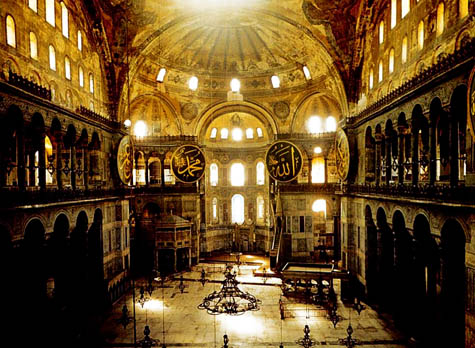 [Image: Inside Hagia Sophia; via].
[Image: Inside Hagia Sophia; via].While scuba diving beneath Hagia Sophia, an exploratory team led by filmmaker Goksel Gülensoy has "managed to reach areas that until now, no one had ever managed to reach," down there in flooded basins 1000 feet beneath Istanbul's heavily touristed religious structure.
In the process, they have discovered 800-year old submerged graves containing the remains of "canonized children."
This was just part of a larger, underwater archaeo-spatial survey:
- The divers and specialists explored the connection of the basins underneath Aghia Sophia with the aqueduct and the palace of Top Kapi. In addition they attempted to locate the secret tunnels from Tekfour Palace to the Islands.
Either way, I have long been fascinated by the idea of scuba diving beneath – if not actually through – architectural structures, so I am definitely looking forward to watching Gülensoy's forthcoming documentary about these discoveries. That film, appropriately enough entitled In the Depths of Hagia Sophia, will begin screening at film festivals this autumn.
"I believe what is beneath Hagia Sophia is much more exciting than what is above the surface," Gülensoy explained to the Hürriyet Daily News and Economic Review. There, we read about the flooded basins in more detail:
- Years ago, Erdem Yücer, one of the former directors of the museum, had shown Gülensoy a photograph that was taken of the foundations of Hagia Sophia. The photo showed researchers in a boat in a place filled with water, resembling the Yerebatan Cisterns. Seismic research had also demonstrated that the area underneath the big hall was empty. The team, which had previously lowered a camera down from the second door during the first exploration, was thrilled to see two passages extending to the center of the building and to the exit door – passages that might extend to Yerebatan and Topkapi.
In any case, the Hürriyet article includes short descriptions of the actual tunnels beneath Hagia Sophia, and it mentions plans for these otherwise archaeologically unknown spaces to be scanned for later study. This latter detail reminds me of the Bill Stone video that I linked a few days back.
(With thanks to John Maas! Vaguely related: recreational fishing in the basements of Manhattan).
No comments:
Post a Comment